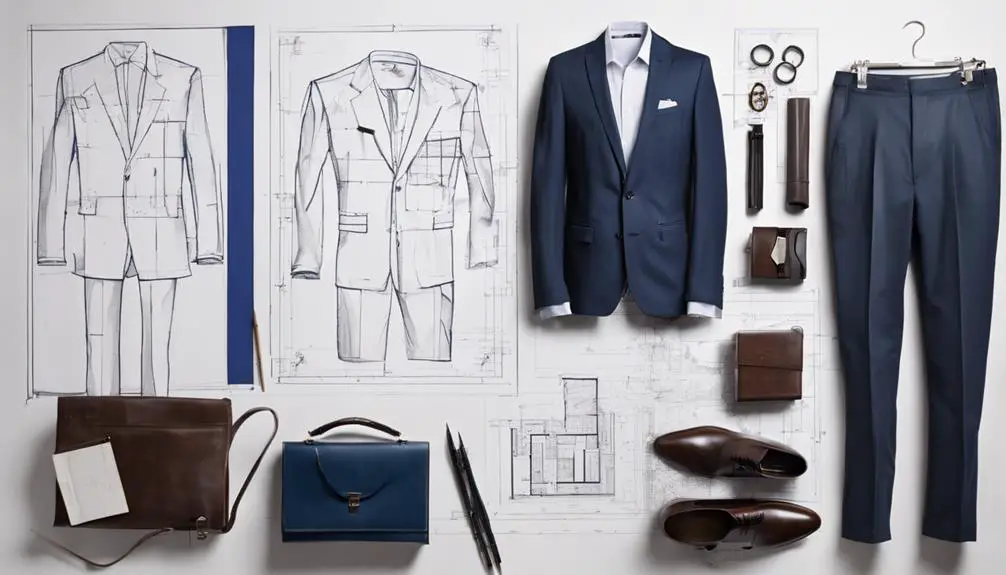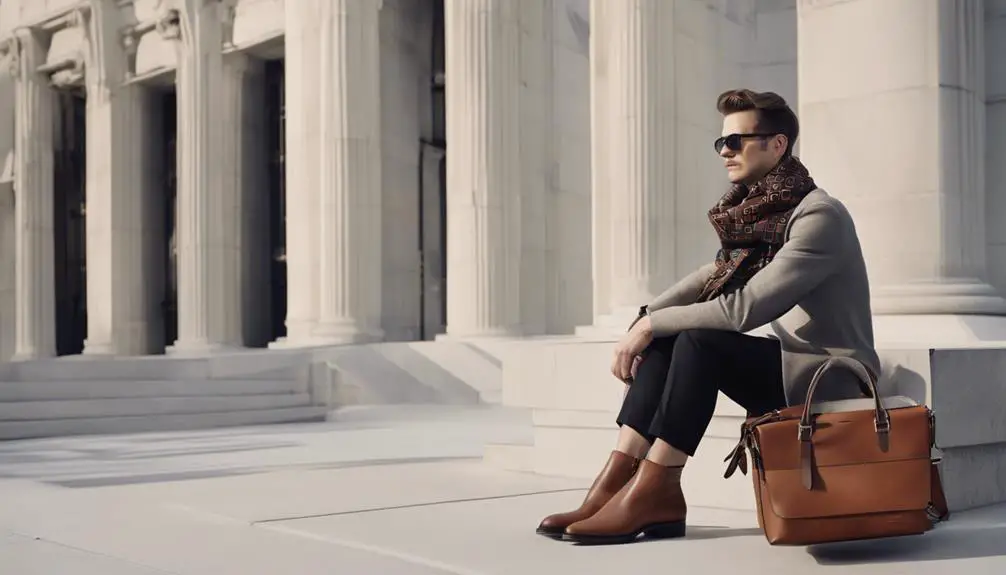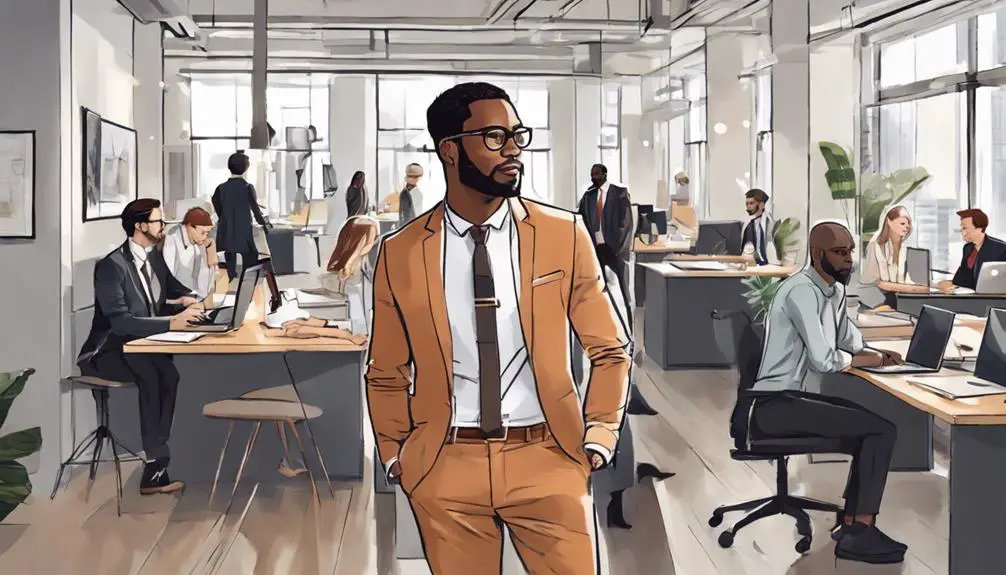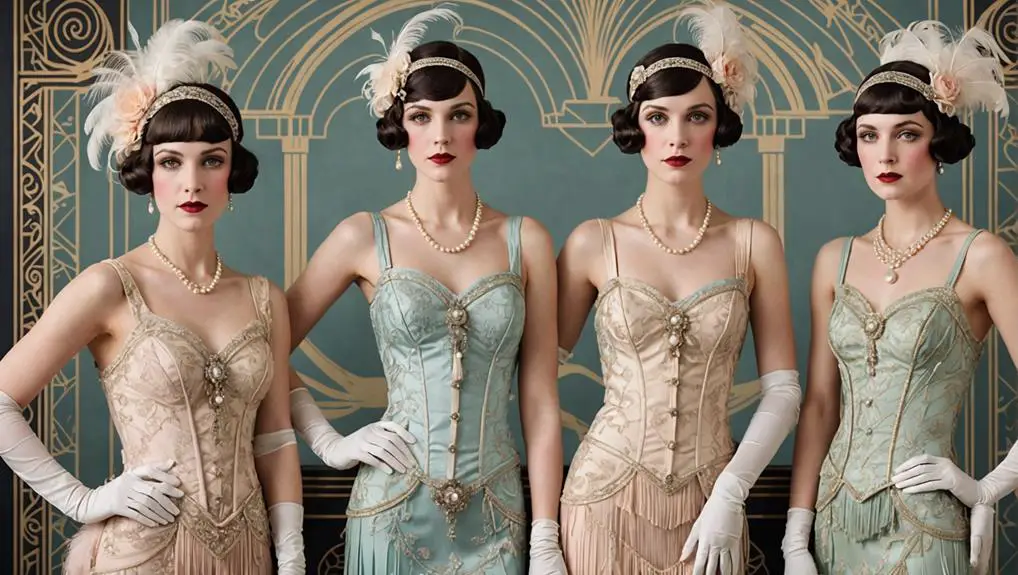To dress as an architect, aim for a stylish balance between professionalism and personal expression. For daily office wear, tailored dress pants and shirts paired with polished shoes work well. When meeting clients or attending formal events, a suit is often appropriate. Casual workdays allow for jeans or chinos with smart polos, while construction site visits require closed-toe shoes, prioritizing safety. Layering with blazers or cardigans adds sophistication. Remember, your attire should reflect your firm's culture and your creative self! Want to elevate your architect wardrobe further? There's more exciting information awaiting you!
Architectural Dress Code Essentials

When it comes to architectural dress code essentials, striking the right balance between professionalism and personal style is crucial. As an architect, your attire often reflects your expertise and creativity, particularly within a business casual framework. You'll typically want to opt for dress pants, dress shirts, and polished dress shoes for daily office wear. This smart-casual aesthetic not only keeps you looking sharp but also aligns with the expectations of most firms.
However, remember that your clothing choices should adapt to your firm's culture, the nature of your projects, and client interactions. For high-profile meetings, you might need more formal attire like suits and ties to convey gravitas. When visiting construction sites, prioritize comfort and practicality. Closed-toe shoes are essential, and don't forget any required safety gear.
While adhering to the dress code, you can still express your individuality through patterns and colors that reflect your personality, as long as they remain professional. Personal grooming and attention to detail in your clothing choices contribute notably to a polished appearance, reinforcing your credibility and fostering positive first impressions with clients and stakeholders.
Ultimately, dressing well as an architect isn't just about following a set of rules; it's about showcasing your unique style while respecting the professional environment you're in. So, embrace the art of dressing, and let your attire speak volumes about your commitment to your craft!
Daily Attire for Architects
When it comes to your daily attire as an architect, striking the right balance between professionalism and creativity is key. You'll want to choose versatile combinations that keep you comfortable on your feet while also showcasing your personal style—think dress pants with a stylish shirt or a smart pair of jeans with a polished polo. Ultimately, your outfit should reflect both your firm's culture and the projects you tackle, allowing you to express your unique flair while maintaining a professional edge.
Professional Yet Creative Choices
Balancing professionalism and creativity in your daily attire as an architect is essential for making a strong impression. You want to dress appropriately while showcasing your unique style. Here are three key choices to take into account:
- Tailored Trousers and Dress Shirts: Opt for fitted trousers combined with crisp dress shirts for meetings or client interactions. This combo exudes professionalism while allowing you to express your personality through color or patterns.
- Comfortable Footwear: Choose stylish loafers or clean sneakers for long hours at the office or on-site. Your comfort directly impacts productivity, and the right footwear can elevate your overall look.
- Minimal Accessories: Keep accessories functional and understated, like a sleek watch or a practical messenger bag. These items maintain a professional appearance without overshadowing your outfit.
Incorporating neutral colors like black, white, and grey gives your wardrobe versatility, easily adapting from casual to formal settings. Remember, how architects dress not only reflects their professionalism but also their creativity, so make thoughtful choices that represent who you are!
Comfort Meets Style Balance
Finding the right balance between comfort and style is key for architects maneuvering their busy days. You'll want to choose daily attire that allows for ease of movement, especially when you're on-site or in the office for long hours. Casual options like jeans or chinos paired with a polo or button-down shirt offer a polished yet relaxed look.
When it comes to footwear, opt for comfortable loafers or stylish sneakers since you'll often find yourself on your feet during client meetings or site visits. A minimalist color palette—think black, white, and grey—can simplify your wardrobe choices, ensuring you look professional without sacrificing comfort. This approach also reduces decision fatigue during those hectic mornings.
For accessories, keep it minimal and understated. A practical bag or briefcase not only carries your work documents but also enhances your polished appearance. If you're a female architect, consider dresses or skirts paired with blouses; they provide both comfort and confidence while adhering to workplace dress codes. By blending comfort with style, you'll be ready to tackle your day without compromising your professional image.
Versatile Outfit Combinations
Creating versatile outfit combinations is essential for architects who need to navigate a range of professional settings. You'll want to strike a balance between style and comfort while ensuring you're prepared for anything the day throws at you. Here are three key components to reflect on:
- Well-Fitted Bottoms: Opt for jeans or chinos that fit well; they pair perfectly with a button-down dress shirt or a smart polo.
- Layering Pieces: Incorporate blazers or cardigans for those unpredictable office temperatures or important client meetings. These layers not only add sophistication but also versatility.
- Footwear: Choose comfortable yet stylish options like loafers or minimalist sneakers. They're ideal for long hours in the office or on-site visits, keeping you both professional and practical.
Accessories and Footwear Choices

When it comes to accessories and footwear choices, you'll want to strike a balance between style and function that reflects your professionalism as an architect. Opt for comfortable, closed-toe shoes that provide support during those long site visits, while minimal accessories like simple jewelry or coordinated ties can polish your look without stealing the spotlight. Remember, a well-chosen bag or briefcase not only keeps your essentials organized but also adds an extra layer of sophistication to your overall appearance.
Essential Footwear Selection
Choosing the right footwear is essential for architects, balancing comfort and professionalism while ensuring safety on site. Your footwear selection can make a significant statement about your professional standard, so it's imperative to choose wisely. Here are three key options to take into account:
- Steel-Toed Boots: For construction sites, these are non-negotiable. They protect your feet from heavy equipment and materials, ensuring you stay safe while working hard.
- Loafers or Chic Sneakers: In office settings, stylish yet practical shoes can maintain your professional appearance. They keep you comfortable during long hours of meetings and site visits without compromising on style.
- Weather-Appropriate Shoes: Don't forget to take into account the elements! Breathable materials for hot days and insulated options for colder weather are essential for maintaining comfort and safety.
Practical Accessory Guidelines
Accessories play an essential role in completing your architect look, balancing functionality with style. When selecting accessories, aim for minimal and understated pieces. Simple jewelry, like a sleek watch or subtle earrings, enhances your polished appearance without being distracting. Coordinated ties and belts can also elevate your outfit, reflecting your personal style while guaranteeing professionalism.
Next, consider practical bags or briefcases to carry your work documents and tools. A sturdy, stylish bag not only serves a functional purpose but also communicates your commitment to professionalism. Opt for closed-toe shoes, such as loafers or steel-toed boots, especially for site visits. These choices guarantee both safety and a professional image, vital when maneuvering construction environments.
Style and Function Balance
Striking a balance between style and function is essential for architects, especially when it comes to footwear and accessories. Your choices can reflect professionalism while ensuring comfort during long site visits and client meetings. Here are three key considerations to keep in mind:
- Footwear: Opt for closed-toe dress shoes that are both comfortable and durable. This choice not only enhances your formal attire but also prioritizes safety on-site. Consider breathable materials for hot weather and warmer options for colder climates.
- Accessories: Keep accessories minimal and understated. Simple jewelry or a stylish watch can elevate your look without distracting from your overall professionalism. Tailored belts and coordinated ties offer a chance for self-expression while adhering to firm culture.
- Bags: Invest in practical bags or briefcases to carry your work documents and tools. A polished appearance is vital, and a well-chosen bag can enhance that while maintaining functionality.
Dressing for Construction Sites
Safety is paramount when dressing for construction sites, so you'll want to prioritize protective gear. This means investing in quality items that not only keep you safe but also allow for comfort and movement throughout the day. Think hard hats, steel-toed boots, and high-visibility clothing. These essentials are vital for compliance with safety regulations while showcasing your professionalism in the field.
When selecting your outfit, consider practical clothing that adapts to varying weather conditions. Breathable fabrics are ideal for hot days, while layering helps combat the chill in cooler weather. However, avoid loose-fitting items; they can easily snag on machinery, leading to accidents. Instead, opt for fitted but comfortable attire.
Closed-toe shoes are a must, and durable footwear is necessary for those long hours spent on-site. Remember, adhering to site-specific dress codes reflects your understanding of the work environment and your commitment to safety.
Here's a quick reference table to help you visualize the essential items for construction site attire:
| Item | Purpose | Recommended Type |
|---|---|---|
| Hard Hat | Protects against head injuries | Compliant with safety standards |
| Steel-Toed Boots | Guards feet from heavy objects | Slip-resistant, durable |
| High-Visibility Clothing | Guarantees visibility in low-light areas | Bright colors, reflective materials |
Impact of Firm Culture on Dress

The dress code you encounter as an architect often reflects the culture of your firm, shaping how you present yourself in the workplace. Different firms have distinct atmospheres that influence your attire, and understanding this can be important for your professional image. Here are three key aspects to keep in mind:
- Client Interactions: Initial meetings often require a polished look to meet a professional standard, showcasing your firm's professionalism and values. For example, wearing vintage Ralph Lauren can convey a sense of timeless elegance and quality that aligns well with a professional setting.
- Location Matters: Urban firms might embrace trendier styles, while suburban firms tend to lean towards traditional business attire. Your surroundings can greatly influence what's acceptable.
- Creative Expression: Some firm cultures encourage the use of creative accessories and patterns, allowing you to balance professionalism with your personal flair.
Navigating these nuances is essential. If you're in a more casual environment, you might feel empowered to express your individual style. However, in a more formal setting, it's important to adhere strictly to the dress code to maintain the firm's image. Misjudgments in attire can affect professional relationships and client perceptions, so keeping a pulse on the firm's culture is significant.
Ultimately, your clothing should reflect not only your personality but also the values and expectations of your firm, ensuring you represent yourself and your workplace effectively. Adapting to your firm's culture helps you communicate professionalism while still being true to who you are.
Personal Style and Professionalism
While it's important to align with your firm's culture, you can still express your personal style in a way that enhances your professionalism. Think of your attire as an extension of your architectural philosophy; every detail counts. Start with quality shoes, belts, and bags—these carefully chosen accessories can elevate your overall look while showcasing your unique flair. Incorporating tailored jackets, such as a structured blazer, can add a polished touch to your outfit, reinforcing your commitment to aesthetics. Always remember that attention to detail is vital; polished shoes and tailored clothing reflect your commitment to professionalism and aesthetic standards.
When opting for casual attire, keep it intentional. You want to avoid a sloppy appearance, but that doesn't mean sacrificing your individuality. Neutral colors like charcoal or dark shades offer a sophisticated canvas that balances personal style with professional expectations. Consider incorporating signature pieces or accessories that communicate your uniqueness without straying too far from workplace norms.
This thoughtful approach allows you to maintain a sense of individuality while adhering to the expectations of your profession. Whether it's a standout watch or a distinctive bag, these elements can make a significant impact. Ultimately, cultivating your personal style within a professional framework not only makes you feel more confident, but it also helps others recognize your dedication to your work. So, embrace your creativity, pay attention to details, and let your personal style shine while embodying the professionalism that defines successful architects. Your wardrobe can truly be a canvas for your architectural identity!
Frequently Asked Questions
What Do You Wear as an Architect?
Imagine a canvas waiting for your brush. You wear business casual attire—dress pants, button-down shirts, or blouses—to blend professionalism with creativity. Your outfit speaks volumes, shaping perceptions before you even say a word.
What Would Be the Best Dress of an Architect if He Is Going to Meet the Client for a New Project?
For a client meeting, you'll want to wear professional attire that exudes confidence. Choose a tailored suit in navy or charcoal, a crisp shirt, and polished shoes to create a refined and trustworthy impression.
What Does a Day as an Architect Look Like?
Imagine you're a time traveler, juggling daily responsibilities as an architect. You'll navigate design processes, meet clients, collaborate with colleagues, and visit sites, all while ensuring your attire matches the tasks and expectations ahead.
What Makes an Architect Stand Out?
To make an architect stand out, you embrace unique design aesthetics that reflect your personality. Balancing creativity with a polished professional identity enhances your credibility, helping you connect effectively with clients and peers alike.





Thanks. Very good stuff.
casino en ligne
You actually expressed this wonderfully.
casino en ligne
Truly a lot of valuable facts!
casino en ligne
Incredible lots of wonderful facts.
casino en ligne France
Nicely put, Thanks.
meilleur casino en ligne
Wonderful write ups. Many thanks.
casino en ligne
Beneficial posts Thanks.
casino en ligne fiable
This is nicely said! .
casino en ligne
Thanks, Numerous data.
meilleur casino en ligne
Amazing knowledge Thank you!
casino en ligne